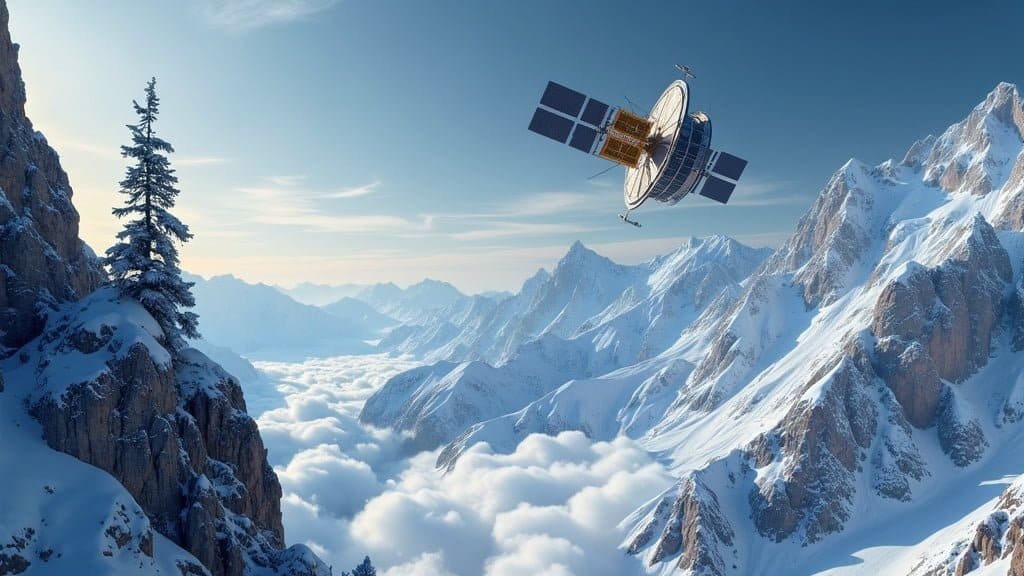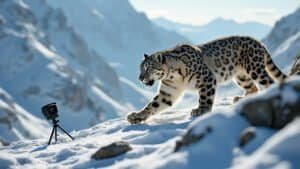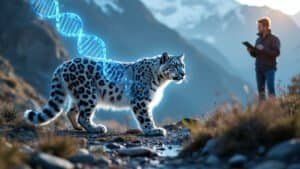Introduction
Studying snow leopard habitats poses significant challenges due to their elusive nature and the rugged, often inaccessible mountainous terrains they inhabit. However, advancements in satellite imagery and remote sensing have revolutionized the way researchers approach this task
These technologies provide critical insights into snow leopard behavior, population tracking, and habitat mapping. This article delves into the importance of satellite imagery, the remote sensing techniques utilized, the challenges faced, and how these tools are shaping the future of snow leopard conservation
The Importance of Satellite Imagery in Mapping Snow Leopard Habitats
Satellite imagery has become a cornerstone in the study of snow leopard habitats, providing unparalleled access to remote and rugged terrains that are otherwise difficult to monitor
Snow leopards reside in some of the world’s most inaccessible areas, such as the high-altitude mountain ranges of Central and South Asia, including the Himalayas, the Altai, and the Tian Shan mountains. These regions are characterized by harsh climates, steep terrains, and vast expanses, making traditional field research challenging and sometimes impossible
Satellite imagery overcomes these obstacles by offering a bird’s-eye view of these habitats, allowing researchers to monitor large areas consistently and accurately
How Satellite Imagery Pinpoints Snow Leopard Locations
One of the critical advantages of satellite imagery is its ability to precisely identify and monitor snow leopard locations over time. By analyzing high-resolution images, researchers can detect the specific terrain features preferred by snow leopards, such as rocky outcrops, ridgelines, and areas with sufficient prey
The imagery allows scientists to map out potential snow leopard habitats by focusing on the environmental variables that influence their distribution, such as altitude, slope, and vegetation cover
For instance, studies have used Landsat and Sentinel satellites to map snow leopard habitats across vast and difficult-to-access regions. By correlating satellite data with known snow leopard sightings, researchers can refine their models to predict other areas where these elusive cats might reside
This capability is crucial in conservation efforts, as it helps identify critical habitats that require protection and enables better-targeted conservation strategies
Mapping Habitat Changes Over Time
Satellite imagery is not only essential for locating snow leopards but also for tracking changes in their habitats over time. As climate change and human activities increasingly impact mountainous ecosystems, the ability to monitor these changes is vital for snow leopard conservation
Satellite data allows researchers to observe shifts in vegetation, snow cover, and human encroachment, all of which can significantly affect snow leopard habitats
For example, researchers have used time-series analysis of satellite images to assess the effects of climate change on snow cover in the Himalayas
These studies reveal how shrinking snow lines and changing vegetation patterns may push snow leopards into higher altitudes or force them into closer contact with human populations, increasing the risk of human-wildlife conflict. By understanding these dynamics, conservationists can better plan for the long-term survival of snow leopards
Advantages Over Traditional Mapping Methods
Traditional methods of studying snow leopard habitats, such as on-the-ground surveys and camera trapping, are often limited by the sheer scale and inaccessibility of the terrain. Satellite imagery offers several advantages over these methods
First, it provides a comprehensive overview of large areas, making it possible to study entire mountain ranges rather than just localized regions. This broader perspective is crucial for understanding the full extent of snow leopard habitats and the connectivity between different population areas
Second, satellite imagery is less invasive and reduces the need for prolonged human presence in fragile ecosystems, minimizing the disturbance to snow leopards and their prey
Additionally, it allows for continuous monitoring, providing up-to-date information on habitat conditions and potential threats. This capability is particularly valuable in regions where political instability or harsh weather conditions make regular fieldwork difficult
Finally, the integration of satellite data with other technologies, such as Geographic Information Systems (GIS) and remote sensing, enhances the ability to create detailed and dynamic habitat models. These models can be used to predict how snow leopard habitats might change in response to various factors, including climate change, human development, and conservation interventions
The result is a more comprehensive and proactive approach to snow leopard conservation, one that leverages cutting-edge technology to protect these iconic and endangered animals
Remote Sensing Techniques Used in Snow Leopard Research
Remote sensing has emerged as a critical tool in the study and conservation of snow leopards, offering detailed insights into their habitats and behaviors
By utilizing various types of sensors and data collection methods, researchers can gather valuable information about the environmental conditions that influence snow leopard distribution
These techniques allow for continuous monitoring and can cover vast and inaccessible areas, making them indispensable in snow leopard research
Types of Remote Sensing Tools
Remote sensing involves the use of different types of sensors and technologies to collect data from a distance, typically using aircraft or satellites
In snow leopard research, the most commonly used tools include multispectral and hyperspectral imaging, LiDAR (Light Detection and Ranging), and thermal infrared sensors:
Multispectral and Hyperspectral Imaging: These tools capture images across multiple wavelengths of light, from visible to infrared. They are particularly useful for mapping vegetation types, snow cover, and geological features. This information helps in identifying potential snow leopard habitats by analyzing the environmental conditions that these cats prefer
LiDAR: LiDAR technology uses laser pulses to create detailed 3D maps of the terrain. In snow leopard studies, LiDAR is used to assess habitat structures, such as cliffs and ridges, that are crucial for snow leopards. This data provides a precise understanding of the topography and can reveal hidden pathways and corridors that snow leopards might use
Thermal Infrared Sensors: These sensors detect heat emitted by objects, making them effective in identifying animals, including snow leopards, in their natural habitat. Thermal imaging can be especially useful at night or in dense vegetation, where snow leopards might be difficult to spot with conventional cameras
Accuracy of Remote Sensing Data
The accuracy of remote sensing data in snow leopard research is remarkably high, particularly when it is combined with ground-truthing methods, such as field surveys and camera traps. By correlating remote sensing data with actual observations, researchers can fine-tune their models to predict snow leopard presence more accurately
For example, studies that integrate remote sensing data with GPS collars worn by snow leopards have shown high levels of accuracy in predicting the cats’ movement patterns and habitat use
The precision of remote sensing allows researchers to distinguish between different types of vegetation and terrain, helping to identify microhabitats that are essential for snow leopard survival
However, the accuracy of remote sensing also depends on factors such as the resolution of the imagery and the quality of the sensors. High-resolution images are crucial for detecting small-scale features like individual boulders or narrow ridges, which are often used by snow leopards for hunting and shelter
As technology advances, the resolution and accuracy of remote sensing data continue to improve, offering even more detailed insights into snow leopard ecology
Integration of Remote Sensing with On-Ground Research
While remote sensing provides a wealth of data, its effectiveness is significantly enhanced when integrated with on-ground research
Field surveys, camera traps, and GPS tracking are essential for validating and enriching the information obtained from remote sensing. This integration allows researchers to create more accurate models of snow leopard distribution and behavior
For instance, camera traps placed in remote sensing-identified potential habitats can confirm the presence of snow leopards and provide additional data on their behaviors and interactions
Similarly, GPS collars used in conjunction with remote sensing can track the movements of individual snow leopards, offering insights into their range, hunting patterns, and migration routes
This combined approach also aids in understanding the impact of environmental changes on snow leopard habitats. For example, by comparing remote sensing data over time with field observations, researchers can monitor how changes in snow cover, vegetation, or human activities are affecting snow leopard populations
This information is crucial for developing effective conservation strategies that address both immediate threats and long-term challenges
Challenges and Limitations of Using Satellite and Remote Sensing
While satellite imagery and remote sensing have revolutionized snow leopard research, they come with their own set of challenges and limitations
These technologies, despite their advantages, must contend with environmental, technical, and data interpretation issues. Understanding these challenges is crucial for effectively using these tools in snow leopard conservation
Environmental and Technical Challenges
One of the primary environmental challenges in using satellite and remote sensing for snow leopard research is the extreme and variable weather conditions in their habitats
Snow leopards live in high-altitude regions where snow, fog, and cloud cover can obscure satellite images and reduce the quality of the data collected. These conditions can lead to gaps in data, making it difficult to obtain consistent and reliable information over time
In addition to environmental factors, the technical limitations of satellites and sensors also pose significant challenges. For example, the resolution of some satellite images might not be sufficient to detect small-scale features critical for snow leopard habitat analysis
Lower-resolution images can miss subtle changes in the landscape, such as small prey trails or minor shifts in vegetation, which are vital for understanding snow leopard ecology
The latency of data acquisition is another technical hurdle. There can be significant delays between the time satellite data is captured and when it becomes available for analysis
This delay can be problematic when monitoring dynamic environments where conditions can change rapidly, such as during seasonal migrations or in response to human encroachment
Data Interpretation Issues
Interpreting the vast amounts of data generated by satellite imagery and remote sensing is a complex task that requires specialized skills and knowledge. One of the main challenges is differentiating between natural and anthropogenic changes in the environment
For instance, distinguishing between seasonal snowmelt and long-term habitat degradation due to climate change can be difficult, yet it is essential for accurate conservation planning
Moreover, remote sensing data often requires ground-truthing to validate the findings. Without field verification, there is a risk of misinterpreting the data, leading to incorrect conclusions about snow leopard habitat and behavior
This is particularly challenging in the remote and rugged terrains where snow leopards live, as conducting fieldwork in these areas is logistically demanding and resource-intensive
Additionally, the integration of data from multiple sensors and platforms can introduce inconsistencies. Different satellites and sensors may have varying levels of resolution, accuracy, and coverage, which can complicate the analysis
Ensuring that the data from various sources is compatible and can be accurately combined is a significant challenge that requires careful calibration and validation
Overcoming Barriers in Remote Sensing Applications
Despite these challenges, several strategies can help overcome the barriers associated with using satellite and remote sensing in snow leopard research. One approach is to improve the resolution and frequency of satellite imagery
Advances in satellite technology, including the development of higher-resolution sensors and more frequent imaging capabilities, are helping to mitigate some of the environmental and technical challenges
Collaborative efforts between organizations and researchers are also key to overcoming data interpretation issues. By combining expertise from different fields, such as ecology, remote sensing, and computer science, more accurate and meaningful insights can be drawn from the data
Initiatives that bring together global data sets and standardize data collection methods are also helping to reduce inconsistencies and improve the reliability of remote sensing applications
The use of machine learning and artificial intelligence (AI) is another promising solution for addressing the challenges of data analysis
AI algorithms can process large volumes of satellite and remote sensing data more efficiently than traditional methods, identifying patterns and anomalies that might be missed by human analysts. These technologies are increasingly being used to automate the detection of snow leopard habitats and to monitor changes over time
Finally, increasing the accessibility and availability of remote sensing data is crucial. Open access to satellite imagery and remote sensing data allows more researchers to engage in snow leopard studies, fostering innovation and collaboration
Initiatives such as NASA’s Earth Observing System Data and Information System (EOSDIS) and the European Space Agency’s Copernicus program provide free access to vast amounts of Earth observation data, which is invaluable for conservation efforts
The Future of Technology in Snow Leopard Conservation
As technology continues to evolve, it promises to play an even more pivotal role in the conservation of snow leopards
The integration of advanced satellite technology, artificial intelligence (AI), and global collaboration efforts are opening new avenues for protecting these elusive big cats. This section explores the future technological advancements and their potential impact on snow leopard conservation
Advancements in Satellite Technology
The next generation of satellites is expected to bring significant improvements in the resolution, frequency, and types of data that can be collected, making them even more valuable in wildlife conservation
One of the most promising developments is the deployment of small, low-cost satellites known as CubeSats. These miniature satellites can be launched in large constellations, providing high-frequency imaging of the Earth’s surface. For snow leopards, this means more up-to-date and detailed monitoring of their habitats
Another exciting development is the use of hyperspectral imaging, which can capture a broader range of wavelengths than current multispectral systems. This technology allows for even more precise identification of vegetation types, snow cover, and geological features in snow leopard habitats
Additionally, radar satellites, which can see through clouds and operate in all weather conditions, are becoming more advanced and accessible. These satellites will provide consistent data, regardless of the challenging weather conditions often found in snow leopard regions
The incorporation of edge computing into satellite systems is another frontier. Edge computing processes data directly on the satellite rather than transmitting it back to Earth for processing
This reduces the time between data collection and analysis, allowing for real-time monitoring of snow leopard habitats and immediate responses to environmental changes
Potential for AI and Machine Learning
Artificial intelligence and machine learning are transforming how researchers analyze the vast amounts of data generated by satellites and other remote sensing tools
These technologies can identify patterns and anomalies that may be too subtle or complex for human analysts to detect. For example, AI can be used to automatically classify different types of terrain and vegetation, identify potential snow leopard habitats, and even predict how these habitats might shift due to climate change or human activities
Machine learning algorithms can also improve the accuracy of wildlife population estimates. By analyzing images from camera traps, drones, and satellites, these algorithms can identify individual animals and track their movements over time
This capability is particularly valuable for snow leopards, whose elusive nature makes traditional population surveys challenging
Moreover, AI can be used to model future scenarios for snow leopard habitats under different environmental and conservation strategies. These predictive models can help conservationists prioritize actions and allocate resources more effectively
For example, AI-driven models can simulate the impact of habitat restoration projects or the effects of climate change on snow leopard populations, providing data-driven guidance for conservation efforts
Collaborations and Global Efforts in Conservation
The future of snow leopard conservation will likely involve increased collaboration among governments, NGOs, research institutions, and local communities. Technological advancements are enabling more effective partnerships by providing shared platforms for data collection, analysis, and decision-making
For example, global initiatives like the Global Snow Leopard and Ecosystem Protection Program (GSLEP) bring together countries within the snow leopard’s range to coordinate conservation efforts, leveraging the latest technology to monitor and protect habitats
International collaboration also extends to the sharing of satellite data and remote sensing tools. Programs like Copernicus and NASA’s Earth observation initiatives provide free access to satellite data, allowing conservationists around the world to monitor snow leopard habitats
These collaborative efforts ensure that even resource-limited regions can benefit from cutting-edge technology in their conservation work
Involving local communities is another critical aspect of future conservation strategies. Technology can empower these communities by providing them with tools to monitor and protect snow leopards in their regions
For instance, smartphone apps and community-based monitoring systems can be integrated with satellite data to enhance local conservation efforts and ensure that the voices of those living alongside snow leopards are heard
Conclusion
Satellite imagery and remote sensing have become indispensable tools in the study and conservation of snow leopard habitats. These technologies allow researchers to overcome the significant challenges posed by the rugged, remote regions that snow leopards inhabit
By providing accurate, large-scale, and continuous data, satellite imagery helps map snow leopard habitats, track changes over time, and identify critical areas for conservation. Remote sensing techniques, when combined with on-ground research, enhance the understanding of snow leopard behavior and habitat use, although they come with challenges like data interpretation and technical limitations
As advancements in satellite technology, AI, and global collaboration continue to develop, the future of snow leopard conservation looks promising, offering more precise and proactive approaches to protecting these elusive cats and their ecosystems






